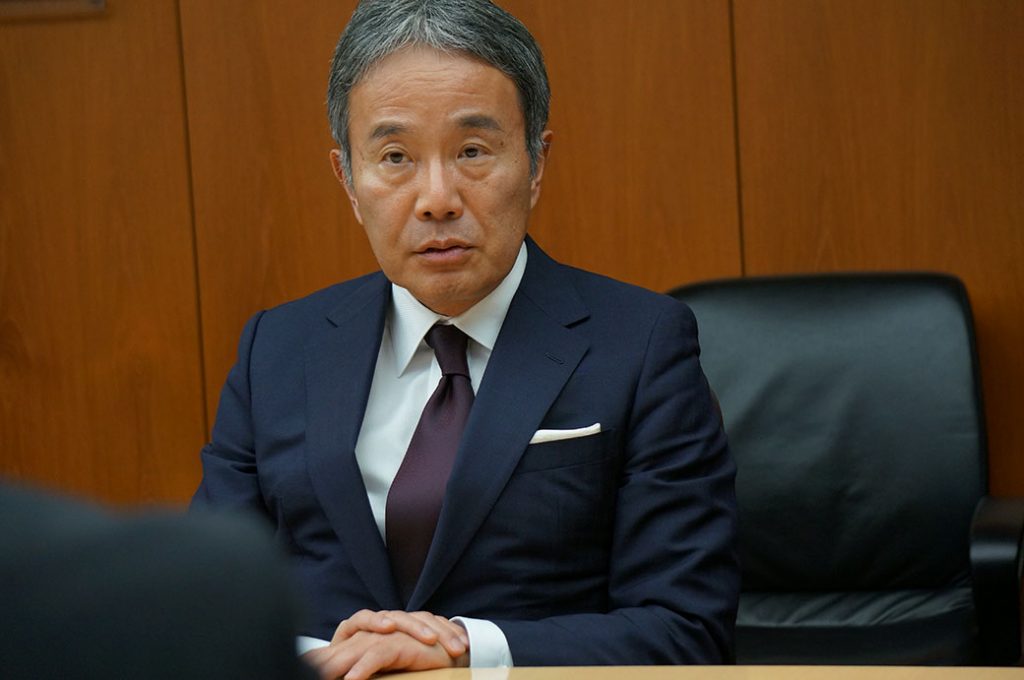
- News
- Basics
- Products
- JP Job shop
- Exhibition
- Interview
- Statistic
- PR
- Download
- Special contents
Interview
January 15, 2020

The average unit price of machine tools has gone up
One trillion yen in sales is in sight
“While the average unit price of machines was 20 million yen 20 years ago, it is approaching close to 50 million yen today,” says Dr. Masahiko Mori, president of DMG MORI. This is because of increased delivery of systems that combine robots with peripherals, in addition to the high functionality of the machines themselves. As such trends accelerate, “One trillion yen in sales will come in sight in 2030,” he says.
– Market conditions remain severe.
I think that the rate of decline in orders received is lower for us than for other companies in the same industry. Direct sales and direct engineering overseas are effective. There has been an increasing number of cases in which, for example, Spanish customers have asked us for equipment because they are going to build a factory in Mexico. It is time for us to work hard to meet such demands steadily.
– What about the outlook for the next decade?
About 300,000 units of the machine tools we have supplied to date are currently in operation around the world. One-third of them, 100,000 units, were delivered more than 20 years ago, and these units are mainly vertical machining centers (MCs). Replacement of them will soon start. Most of them will be replaced with a process integration machine, such as a 5-axis MC or multi-tasking machines; therefore, it is expected that there will be replacement demand for 50,000 units even if the demand is decreased by half in terms of the number of units. Including the above, it is expected that our sales will reach about 800 billion to one trillion yen in 2030. While our existing production capacity is 12,000 units per year, it will expand in conjunction with incidental business for such things as service parts.
– Are there any remarkable changes in the market?
First of all, unit selling prices have been increasing. Changes such as the addition of robots and making tool holders high precision really stand out. So, we have established the DMQP program to certify the quality and maintainability of peripherals, and we meet the needs of customers with our selection of certified products. The average unit price was about 20 million yen 20 years ago, but it is approaching close to 50 million yen today.
– What are the causes of such changes?
Currently, almost 90% of the orders we receive require some form of time study (to show customers the optimum machining conditions for the certain workpieces with suitable peripheral devices and machining cycle times). Developing process together with a customer and delivering a total system, including peripherals—not just selling a machine as a unit—is the image we deliver.
– What about the technical trends in the next decade?
5-axis MCs and multi-tasking machines will be increasingly used, and the trend toward systematization and automation, as I mentioned earlier, will also accelerate. I think that digital twins (realistic machining simulations by building machines and equipment in a virtual space) will continue to be used for 80% of process development and that the remaining 20% will be completed with actual physical assets. When a customer consults us about some specific machining, making a rough prediction using a digital twin and replying quickly and accurately may lead to an order. In cutting work, there are more than a dozen main factors to consider, including machine size, machining capacity, tools, coolant, and workpiece material, and it is very difficult to calculate the optimum balance of them. Therefore, we expect that the ability to say, “If machining takes five days according to a competitor’s calculations, we can do it in three days,” will become our strength in the future.
– Many changes are likely to occur.
Measurement is also important. The integration of machining and measurement should be advanced considerably in the next decade. This is because performance of measurements in a machining tool up to corrective machining is efficient in the case of parts for which no optimum measurement method has been established, such as turbine blades and gears. For complicated shapes, we have to use vision sensors. However, since we are unable to perform measurements with vision sensors on our own, we will collaborate with a manufacturer that is strong in the field. It is also expected that it will be possible to measure tools for abrasion loss when they are returned to an ATC (automatic tool changer) after cutting. The technologies of artificial intelligence (AI) and the Internet of things (IoT) will be used in such fields of measurement management and tool management.
▶FA industry in 2030: Interview with Masahiko Mori, President, DMG MORI(2/2)
Source: SEISANZAI MARKETING Magazine January 2020 issue
September 16, 2019
September 18, 2019